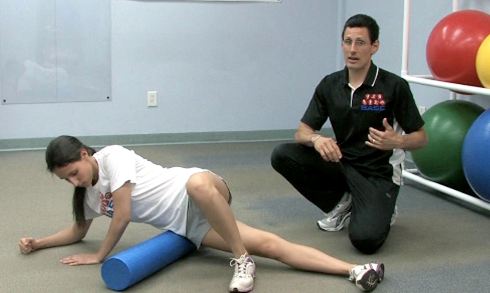As a strength and conditioning coach, I'm often asked about the best way to improve the performance of young athletes. While things like increasing strength and employing better nutritional habits immediately jump to mind, one of my top recommendations - avoiding injury by using a foam roller - usually elicits some rather surprised looks.
Avoiding injury helps performance
Telling a young athlete interested in taking their game to the next level that the key to success depends largely on their ability to avoid injury can be a tough sell to say the least. More often than not, however, the truth is that improving movement efficiency, as well as maintaining the health of muscles and connective tissue is on what they most need to focus.
It doesn't do any good to increase strength if there are already movement restrictions in place that prevent a full range of motion. By getting your child or teen to appreciate the importance of improving things like mobility and tissue quality, instead of just heaping on more intensive training, they can achieve better outcomes, both in terms of overall health and athletic performance.
Don't leave home without it
Enter the foam roller, an unassuming cylindrical tube that can be an athlete's best friend. Used in warm up prior to physical activity, the roller helps increase blood flow to working muscles and connective tissue, making them more pliable and receptive to increases in range of motion. As a recovery tool, the roller serves as form of self-myofascial release, by allowing athletes to essentially "iron out" any knots, adhesions and scar tissue that may have developed due to either previous injury, or chronic overuse.
By simply rolling different muscle groups across a large piece of foam, kids not only better prepare their bodies for exercise, but they can also help speed recovery time from intensive training and sports participation. This type of versatility is exactly why foam rolling should become an essential part of every young athlete's training routine.

One foot versus three foot
Rollers come in a variety of sizes and densities, so young athletes need to be careful in choosing the right one to suit their needs. The three foot round is easily the most popular size, but there's also a one foot round that's ideal for dropping into an equipment bag and taking along with them when they travel. In terms of firmness, beginners should stick with a lighter density (typically white in color), with the option of moving up to a more dense roller down the road.
Consistency is key
As with any other kind of training modality, in order to get the most out of foam rolling, your young athlete will need to be diligent in its use, because rollers need to be used on a regular basis to gain any appreciable benefit. Incorporating rolling as a regular part of your child's warm up before sports practices and training, as well as encouraging its use following activity and during down time are some of the best ways to ensure consistent usage.
Found in most sporting goods stores as well as online retailers, foam rollers are quickly becoming one of the least best kept secrets in youth sports conditioning.
Hurts so good
Don't be too surprised if your child finds rolling to be somewhat uncomfortable at the start. As they begin to make use of a foam roller a regular part of their training, the discomfort will disappear. Before long, you should notice them moving a lot better, as well as recovering from both sports training and workouts at a much faster rate.
Mike Mejia MS, CSCS is the president of B.A.S.E. Sports Conditioning Inc. and a frequent contributor to numerous nationally recognized magazines and websites on the subject of youth athletic development.
Posted December 13, 2011








